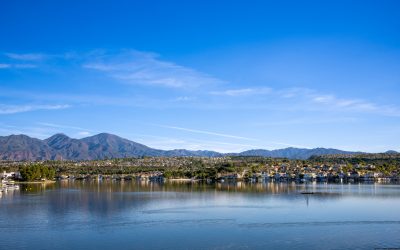Newly elected Orange County Republican leaders are pushing back against funding for California’s controversial high-speed train, even as the state’s rail authority touts progress in creating jobs and building the first stretch of the line.
A new bill from freshman Assemblywoman Laurie Davies, R-Laguna Niguel, calls for shifting $54 million currently set aside for the train and using it to help fund local transit and infrastructure projects that have been financially harmed or delayed by the COVID-19 pandemic.
“This money has been sitting here since 2013 and hasn’t been used for the high-speed rail,” said Davies, who’s on the Assembly’s transportation committee.
“We’ve got shovel-ready projects,” she added. “This will benefit everyone in California.”
Meanwhile, Rep. Michelle Steel, R-Seal Beach, on Monday introduced legislation that would block any federal funding from being used to support California’s high-speed rail project, which she called a “failure.” A slate of local Republicans have signed on to support Steel’s bill, including Reps. Young Kim of La Habra, Mike Garcia of Santa Clarita and Ken Calvert of Corona.
“Costs have continued to rise, while people and businesses have lost their properties,” Steel said. “The sections of the high-speed rail that do exist are inoperable and this is an unacceptable and an embarrassing waste of taxpayer dollars.”
Plans to build a 200-mph bullet train that would carry passengers from Anaheim to San Francisco in under three hours have been discussed for decades as a way to reduce highway congestion, smog, commute times and dependence on foreign oil.
The project began in earnest in 2008. That’s when voters approved nearly $10 billion in bonds for the train, including money to link the project with transit hubs stretching from Sacramento to San Diego.
The entire project was originally supposed to cost around $33 billion and be complete in 2020, but it’s been plagued by delays, cost overruns and litigation. Nearly $8 billion has been spent on the project so far and the current estimated price tag might now soar close to $100 billion. The new predicted completion date for the main route is 2033.
Despite its problems, the project already has created 5,200 jobs and generated $10.5 to $11.4 billion in total economic activity, according to Kyle Simerly, spokesman for California’s High Speed Rail Authority.
The agency is currently building a 119-mile stretch of track in the Central Valley, to connect Bakersfield and Merced. The authority expects to be testing trains on the Central Valley line by 2025, which will make it the only stretch of rail in the country capable of testing at speeds in excess of 185 mph, Simerly noted. If they can get trains certified in 2027, the state plans to offer interim service between Bakersfield and Merced by the end of the decade.
The state sells bonds to help pay for the project each year, as approved by voters under Proposition 1A in 2008. Nearly $3.7 billion in bonds have been sold so far, with nearly $68 million in cash left at the end of 2020.
But in 2013, a Sacramento Superior Court judge blocked the state from selling any Prop 1A bonds because he said backers hadn’t identified where they’d get the rest of the funds needed for the project, as required by the ballot measure. To keep the project moving forward, the legislature approved loaning the train $54 million from the Public Transportation Account, typically used to fund mass transit such as bus and rail throughout the state.
Davies’ bill would require the High Speed Rail Authority to return that $54 million so it can be used for other transportation projects, as the State Transit Assistance fund faces a one-year, 39% revenue drop of $149 million due to COVID-19.
Davies is a former member of the Orange County Transportation Authority, which she said lost almost 40% of its revenue when the pandemic kept people at home and public transit ridership fell sharply. She also was mayor of Laguna Niguel when the pandemic hit, and noted that the city’s public works department had to set aside every infrastructure project that wasn’t safety related, such as plans to widen local roads, because the tax dollars were no longer coming in from shuttered local businesses.
The freshman Assemblywoman campaigned on abandoning the high-speed rail project. In the fall, she told the Register that, if elected, she would “work to prioritize spending on our most important government functions – which does not include a train to nowhere.”
Still, Davies insists that her bill’s plan to refund $54 million set aside for the project won’t stop the train from moving forward. Davies noted that the rail authority has millions in its accounts now, with several funding sources and talk of more money potentially coming from the federal coronavirus relief package.
“So it’s not like it’s coming to a stop,” she said. “But when there’s money that could be used for infrastructure, to me it’s a win-win.”
The High Speed Rail Authority declined to discuss how AB 1049 might impact the train, with Simerly saying they don’t comment on pending legislation.
But in congress, Steel’s bill could stall progress on the project.
Already in 2019, the Trump administration cancelled $929 million in federal funding for California’s bullet train that was approved by the Obama administration nine years earlier. The Federal Railroad Administration said California had failed to “make reasonable progress on the project,” or comply with other terms of the 2010 agreement, which required the first segment of the train to be operable by 2022.
With the first stretch of track not expected to come online until the end of the decade, California could be asked to refund more than $2 billion already provided under the 2010 agreement.
“California has had over a decade to get this project on track and has failed to do so,” Steel said. “My bill ensures this poorly run, money-pit project will not receive any more federal funding.”
These bills from Steel and Davies are expected to head to transportation committee hearings before they might get any floor votes. Since the state Assembly and the House of Representatives are both under Democratic majorities, and Democrats have largely supported high-speed rail and other efforts to boost mass transit, both bills face an uphill climb.
But Davies said she’s been adamant about only taking on legislation that she believes has bipartisan appeal. And she hopes her Democratic colleagues will side with her in focusing for now on COVID-19 relief before protecting funding for the rail project.



